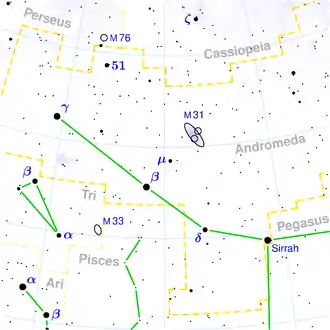Andromeda I
Andromeda I ist eine spheroidale Zwerggalaxie (dSph) im Sternbild der Andromeda.[5] Die Galaxie ist etwa 2,4 Millionen Lichtjahre von unserem Sonnensystem entfernt.[4] Andromeda I ist Mitglied der Lokalen Gruppe und ist ein Satellit der Andromedagalaxie (M31).
| Galaxie Andromeda I | |
|---|---|
 | |
| Andromeda I, aufgenommen durch das Hubble-Weltraumteleskop | |
| AladinLite | |
| Sternbild | Andromeda |
| Position Äquinoktium: J2000.0, Epoche: J2000.0 | |
| Rektaszension | 00h 45m 39,8s[1] |
| Deklination | +38° 02′ 28″[1] |
| Erscheinungsbild | |
| Morphologischer Typ | E3 pec/dSph[1] |
| Helligkeit (visuell) | 13,6 mag[1] |
| Winkelausdehnung | 2,5′ × 2,5′[1] |
| Physikalische Daten | |
| Rotverschiebung | −0,001228 ± 0,000037[1] |
| Radialgeschwindigkeit | (−368 ± 11) km/s[1] |
| Entfernung | (2.400.000 ± 80.000) Lj / (735.000 ± 23.000) pc [2][3][4] |
| Geschichte | |
| Entdeckung | Sidney van den Bergh |
| Entdeckungsdatum | 1970 |
| Katalogbezeichnungen | |
| PGC 2666 • And I,[2] Anon 0043+37,[1] | |
Eigenschaften
Die Zwerggalaxie befindet sich grob 3,5 Grad südlich und leicht östlich von M31.[6] Sie ist damit Stand des Jahres 2005 die sich am nächsten befindliche Satellitengalaxie Andromedas[7] mit einer geschätzten projizierten Entfernung von etwa 40 kpc[4] oder 150.000[6] Lichtjahren.
Andromeda I wurde im Jahr 1970 von Sidney van den Bergh[8] mit dem 1,2 m Oschin-Schmidt-Teleskop auf dem Palomar-Observatorium entdeckt.[5] Weitere Untersuchungen an Andromeda I wurden mit der Wide Field/Planetary Camera 2 des Hubble-Weltraumteleskops vorgenommen.
Diese fanden wie bei anderen spheroidalen Zwerggalaxien auch eine hauptsächlich von Roten Riesen dominierten Horizontalast.[9] Dadurch und die zusätzliche Bestimmung der Häufigkeit der blauen Sterne am Horizontalast sowie die Entdeckung von 99 RR-Lyrae-Sternen im Jahr 2005[7] konnte man zeigen, dass Andromeda I eine ausgedehnte Ära der Sternentstehung von etwa abgeschätzten 10 Milliarden Jahren durchlebte. Das Hubble-Teleskop entdeckte darüber hinaus einen Kugelsternhaufen als Begleiter von Andromeda I, was sie zur lichtschwächsten Galaxie mit einem derartigen Trabanten macht.[10]
Einzelnachweise
- NASA/IPAC Extragalactic Database. In: Results for Andromeda I. Abgerufen am 21. Januar 2008.
- I. D. Karachentsev, V. E. Karachentseva, W. K. Hutchmeier, D. I. Makarov: A Catalog of Neighboring Galaxies. In: Astronomical Journal. Band 127, Nr. 4, 2004, S. 2031–2068, doi:10.1086/382905, bibcode:2004AJ....127.2031K.
- I. D. Karachentsev, O. G. Kashibadze: Masses of the local group and of the M81 group estimated from distortions in the local velocity field. In: Astrophysics. Band 49, Nr. 1, 2006, S. 3–18, doi:10.1007/s10511-006-0002-6, bibcode:2006Ap.....49....3K.
- A. W. McConnachie, M. J. Irwin, A. M. N. Ferguson, R. A. Ibata, G. F. Lewis, N. Tanvir: Determining the location of the tip of the red giant branch in old stellar populations: M33, Andromeda I and II. In: Monthly Notices of the Royal Astronomical Society. Band 350, Nr. 1, Mai 2004, S. 250, doi:10.1111/j.1365-2966.2004.07637.x, arxiv:astro-ph/0401453, bibcode:2004MNRAS.350..243M.
- Sidney van den Bergh: Search for Faint Companions to M31. In: Astrophysical Journal. Band 171, Januar 1972, S. L31, doi:10.1086/180861, bibcode:1972ApJ...171L..31V.
- Andromeda I. In: Students for the Exploration and Development of Space (SEDS). 25. Juli 2001 (seds.org).
- Barton J. Pritzl, Taft E. Armandroff, George H. Jacoby, G. S. Da Costa: The Dwarf Spheroidal Companions to M31: Variable Stars in Andromeda I and Andromeda III. In: The Astronomical Journal. Band 129, Nr. 5, Mai 2005, S. 2232–2256, doi:10.1086/428372, arxiv:astro-ph/0501083, bibcode:2005AJ....129.2232P.
- A. W. McConnachie, M. J. Irwin, A. M. N. Ferguson, R. A. Ibata, G. F. Lewis, N. Tanvir: Distances and metallicities for 17 Local Group galaxies. In: Monthly Notices of the Royal Astronomical Society. Band 356, Nr. 4, 2005, S. 979–997, doi:10.1111/j.1365-2966.2004.08514.x, arxiv:astro-ph/0410489, bibcode:2005MNRAS.356..979M.
- G. S. Da Costa, T. E. Armandroff, Nelson Caldwell, Patrick Seitzer: The Dwarf Spheroidal Companions to M31: WFPC2 Observations of Andromeda I. In: Astronomical Journal. Band 112, Dezember 1996, S. 2576, doi:10.1086/118204, arxiv:astro-ph/9610083, bibcode:1996AJ....112.2576D.
- E. K. Grebel, A. E. Dolphin, P. Guhathakurta: Discovery of a Globular Cluster in M31's Dwarf Spheroidal Companion Andromeda I. In: Astronomische Gesellschaft Abstract Series. Band 17, Abstracts of Contributed Talks and Posters presented at the Annual Scientific Meeting of the Astronomische Gesellschaft, 18. September 2000, bibcode:2000AGM....17..P61G.

.jpg.webp)